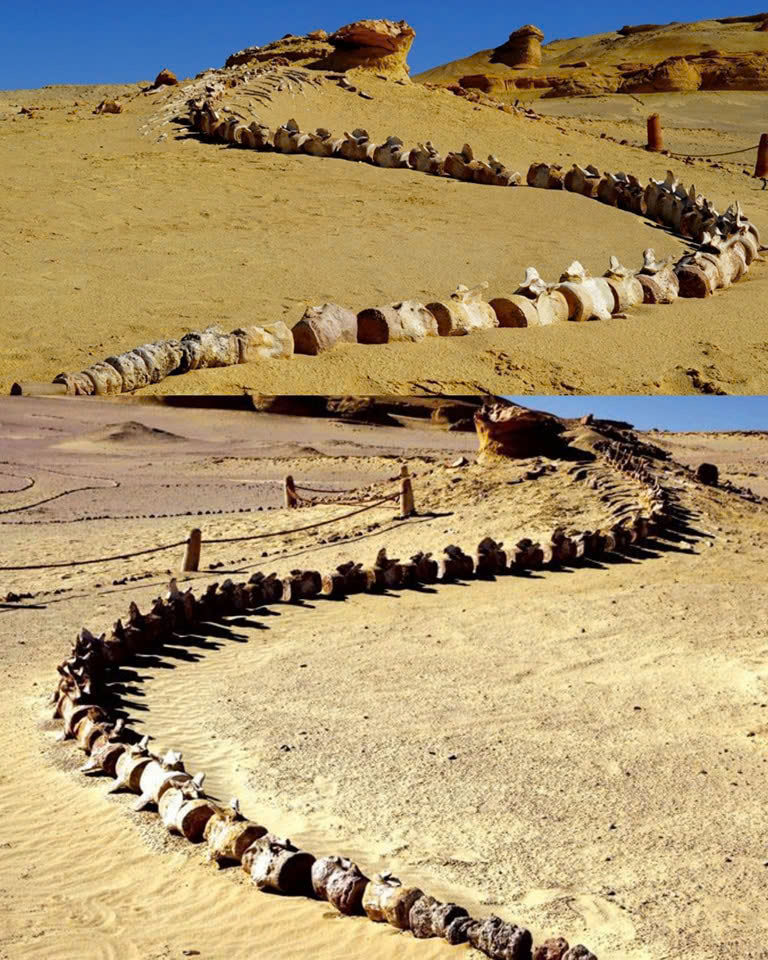Hidden deep within Egypt’s vast Sahara Desert lies a discovery so extraordinary, it’s transforming how we understand the evolution of life on Earth. Scattered across the golden sands are the fossilized remains of ancient whales—majestic creatures that once dominated the oceans nearly 37 million years ago. Dubbed the “walking whales” of Egypt, these prehistoric marine giants offer groundbreaking insights into the evolutionary journey of whales from land-dwelling mammals to the ocean’s most formidable rulers. Their presence in what is now an arid desert landscape paints a vivid picture of a time when Egypt was submerged beneath a vast prehistoric sea.

The discovery of these ancient whale fossils is nothing short of astonishing. In the shifting dunes of Egypt’s Wadi Al-Hitan—also known as the Valley of Whales—paleontologists have unearthed dozens of fossilized remains, including a remarkable 65-foot-long (20-meter) skeleton of a legged whale. This discovery not only challenges our perception of the region’s geological history but also significantly enhances our understanding of one of the most fascinating transitions in the animal kingdom: the transformation of terrestrial mammals into fully aquatic beings. These fossils serve as critical evidence of how evolution operates over millions of years, adapting species to new environments and conditions in ways that continue to amaze scientists and the public alike.
Wadi Al-Hitan is now recognized globally as a treasure trove of prehistoric marine life. In recognition of its unparalleled significance, a $2.17 billion (£1.5 billion) museum was constructed to preserve and exhibit these fossils for future generations. The museum, situated at the heart of the Valley of Whales, stands as a powerful symbol of the fusion between natural history and modern conservation efforts. Once a thriving seabed teeming with ancient life, this area now serves as an open-air museum that bears witness to the ever-changing nature of our planet.
Designed by architect Gabriel Mikhail, the museum seamlessly integrates with its desert surroundings. The sand-colored dome-shaped structure mirrors the earthy tones of the surrounding landscape, ensuring that it complements rather than disrupts the natural beauty of the area. Mikhail remarked, “It would be a crime against nature to construct something in such a stunning and distinctive location if it didn’t blend in with the surroundings.” His architectural vision emphasizes sustainability and respect for the environment, providing a model for future projects situated in ecologically sensitive areas.
Inside the museum—officially known as the Fossils and Climate Change Museum—visitors are taken on a journey through time. Carefully curated exhibits feature the ancient whale fossils displayed in sleek glass cases, allowing guests to observe every detail of these remarkable skeletons. From the elongated vertebrae to the vestigial limbs that hint at their terrestrial origins, the fossils tell a compelling story of adaptation and survival. Alongside these marine relics, stone-age tools and artifacts are also on display, revealing that early humans once inhabited this region thousands of years ago. These exhibits connect two vastly different epochs, illustrating how the same landscape has hosted both ancient whales and prehistoric humans, each leaving their mark on the Earth’s geological record.
Perhaps most striking about this discovery is the way it underscores the dynamic and unpredictable nature of our planet. The very idea that whales—now icons of the ocean—once roamed shallow seas that covered the Sahara Desert is a powerful reminder of the Earth’s constant state of flux. Shifting tectonic plates, changing climates, and rising and falling sea levels have continuously reshaped the planet, creating and erasing habitats over eons. The fossilized “walking whales” of Egypt offer direct evidence of this process, bridging the gap between past and present, and serving as a stark reminder of the fragile balance that sustains life on Earth.
For scientists, these fossils are a treasure trove of data. They offer rare and valuable insights into whale evolution, particularly the transition from four-legged land mammals to fully aquatic whales. Understanding this evolutionary path not only enriches our knowledge of cetaceans but also enhances our broader comprehension of evolutionary biology, adaptation, and survival. These discoveries also raise awareness of the importance of preserving fossil sites, which are often at risk from human activity and environmental changes.
For the general public, Wadi Al-Hitan offers an unparalleled opportunity to connect with deep history in a visceral and tangible way. Standing before the fossilized remains of creatures that swam in ancient seas millions of years ago instills a profound sense of wonder and humility. It encourages reflection on our own place in Earth’s history and the responsibility we bear in preserving the planet’s natural and cultural heritage.
As we stand in the presence of these 37-million-year-old giants, now resting silently in the heart of the desert, we are reminded of the power of nature to both create and transform. The story of Egypt’s walking whales is not just one of scientific interest—it is a story of mystery, discovery, and awe. It is a call to appreciate the wonders hidden beneath our feet and to protect the fragile clues left behind by ancient worlds. In exploring these relics of the past, we deepen our connection to the Earth’s history and reaffirm our commitment to uncovering, understanding, and honoring the incredible journey of life.





